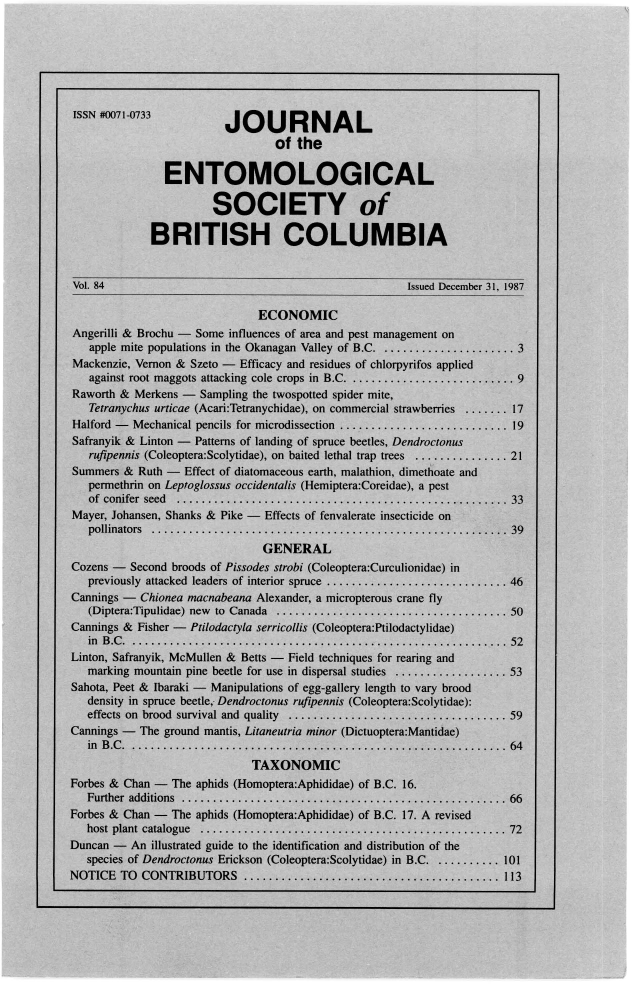Efficacy and residues of chlorpyrifos applied against root maggots attacking cole crops in British Columbia
Abstract
Chlorpyrifos proved to be as effective as chlorfenvinphos, and more effective than fensulfothion and diazinon for cabbage maggot control in root and stem crucifers. For short season crops such as cauliflower, broccoli and cabbage, the granular formulation applied at seeding, followed in 21 days with a single drench of the emulsifiable liquid formulation was adequate. In Brussels sprouts, the slowest of the stem crucifers to mature, a minimum of two drench applications were necessary for acceptable control. In rutabaga, another long season crop, chlorpyrifos 15G applied at seeding followed by 3 drench applications (i.e., at 21-day intervals) after seeding was necessary to produce rutabagas with acceptable damage levels at harvest. In the sandy-clay loam where these studies were undertaken, chlorpyrifos applied at the dosage rates and at the times prescribed for the stem and root crucifers studied did not give rise to appreciable residues at harvest. These studies show that a pre-harvest interval of 32 days would be appropriate for the 5 crops studied.References
Felsot, A.S., J.V. Maddox, and B. Willis. 1981. Enhanced microbial degradation of carbofuran in soils with histories of Furadan use. Bull. Environ. Contam. Toxicol. 26:781-788.
Felsot, A.S., J.G. Wilson, D.E. Kuhlman, and K.L. Steffey. 1982. Rapid dissipation of carbofuran as a limiting factor in corn rootworn (Coleoptera: Chrysomelidae) control in fields with histories of continuous carbofuran use. J. Econ. Entomol. 75:1098-1103.
Finlayson, D.G., M.D. Noble, and H.G. Fulton. 1967. Protection of stem crucifers from cyclodiene-resistant maggots in sandy loam and peat soils. J. Econ. Entomol. 60(1):132-137.
Finlayson, D.G. and J.R. Mackenzie. 1979. Combination sprays for control of foliar pests of Brussels sprouts. Pesticide Research Report, Expert Committee for Pesticide Use in Agriculture.
Finlayson, D.G., J.R. Mackenzie, and C.J. Campbell. 1980. Interactions of insecticides, a carabid predator, a staphylinid parasite, and cabbage maggots in cauliflower. Environ. Entomol. 9:789-794.
Forbes, A.R. 1962. Oviposition of the cabbage fly, Hylemya brassicae (Bouche) (Diptera: Anthomytidae) in coastal British Columbia. Proc. Entomol. Soc. Brit. Columbia 539:47-49.
Harris, C.R., H.J. Svec, W.W. Sans, A. Hikichi, S.C. Phatak, R. Frank, and H.E. Braun. 1975. Efficacy, phytotoxicity, and persistence of insecticides used as pre- and post-planting treatments for control of cutworms attacking vegetables in Ontario. Proc. Entomol. Soc. Ont. 105:65-75.
King, K.M., A.R. Forbes, D.G. Finlayson, H.G. Fulton, and A.J. Howitt. 1955. Co-ordinated experiments on chemical control of root maggots in rutabagas in British Columbia and Washington, 1953. J. Econ. Entomol 48:470-473.
King, K.M. and A.R. Forbes. 1954. Control of root maggots in rutabagas. J. Econ. Entomol. 47(4):607-615.
King, K.M. and A. R. Forbes. 1958. fen years’ field study of methods of evaluating root maggot damage and its control by chemicals in early cabbage. Proc. 10th. Int. Cong. of Entomol (Ital). 3:307-311.
Mackenzie, J.R. and R.S. Vernon. 1984. Efficacy of soil-applied chlorpyrifos granules against root maggots attacking cole crops. Pesticide Research Report, Expert Committee for Pesticide Use in Agriculture. p.84.
Simonet, D.E. 1981. Cabbage maggot control on direct seeded cabbage, 1980. K. Sorensen (ed.). Insecticide and Acaracide Tests. Ent. Soc. of America Pub., College Park, Maryland. (6)62.
Sweeney, M. District Horticulturist. British Columbia Ministry of Agriculture and Fisheries, Abbotsford, B.C.
Downloads
Published
Issue
Section
License
Authors who publish with the Journal of the Entomological Society of British Columbia agree to the following terms:
-Authors retain copyright and grant the journal right of first publication with the work simultaneously licensed under a Creative Commons Attribution License that allows others to share the work with an acknowledgement of the work's authorship and initial publication in this journal.
-Authors are able to enter into separate, additional contractual arrangements for the non-exclusive distribution of the journal's published version of the work (e.g., post it to an institutional repository or publish it in a book), with an acknowledgement of its initial publication in this journal.
-Authors are permitted and encouraged to post their work online (e.g., in institutional repositories or on their website) prior to and during the submission process, as it can lead to productive exchanges, as well as earlier and greater citation of published work (See The Effect of Open Access).


